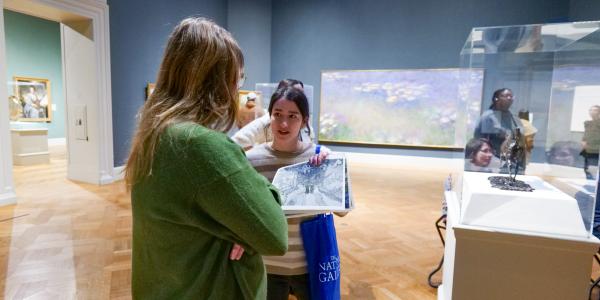Through a partnership with the Saint Louis Art Museum and MindsEye Radio, seven students and their professor, Elizabeth Childs, spent a semester immersing themselves in the art of Vincent van Gogh and making the famous works accessible to those with visual impairments.

Van Gogh exhibition.
Imagine the color blue. Now, try describing it without naming it. Would you evoke the vastness of the sky or the tranquility of flowing water? Would you draw on other senses or mention the emotions it stirs in you?
This is one of the challenges Elizabeth Childs, the Etta and Mark Steinberg Professor of Art History, put to her students this semester. For two days in December, the students in her course “Van Gogh: Creativity, Mythology and Modern Art” ran audio description tours for visually impaired guests at the Saint Louis Art Museum (SLAM).
The students — two undergraduates and five graduate students — became deeply immersed in Van Gogh's paintings throughout the semester. In October, they traveled to London to view a blockbuster exhibition, "Van Gogh Poets and Lovers" at the National Gallery. There, they met with curator Cornelia Homburg — a former curator at WashU's Mildred Lane Kemper Art Museum — and studied 61 works by Van Gogh, many of which had never been shown outside private collections. Each student gave a brief oral report in front of an object they had previously selected. Back in St Louis, they completed an exhibition review and wrote a scholarly essay exploring a larger theme connected to the Van Gogh works they had studied.
But that wasn’t all Childs had in mind for her students. “I wanted their experience this semester to be broader, and I wanted them to think about the difference between the academic and critical museum community and the larger public,” she said.
The words “Dedicated to Art and Free to All” are engraved on a stone facade over the Saint Louis Art Museum's doors. Childs believes the Van Gogh audio description tours, designed with SLAM staff, help fulfill the museum’s mission to serve all — including those with visual impairments that prevent them from enjoying art in traditional ways.

in front of Van Gogh's authentic artwork,
To prepare for working with visually impaired guests, Childs and her students trained with MindsEye Radio, a Belleville-based nonprofit that works to create a more inclusive community for the blind and visually impaired by translating visual experiences into audio. This includes making St. Louis’ most renowned cultural experiences — including the Muny, the Zoo, and Shakespeare in the Park — accessible audio experiences. Childs and her students underwent 16 hours of training through the MindsEye docent training program.
“We emphasize using simple, present action verbs in the audio descriptions,” said Magan Harms, the MindsEye employee who designed the training. “That way, the person listening who is visually impaired is hearing and learning at the same time a viewer sees it.”
Designing a program for visually impaired guests is challenging because impairments can vary. “Some guests may be completely blind and have been blind since birth, but others may be partially impaired and can see shapes or may have had some vision and still remember color,” Childs explained.







